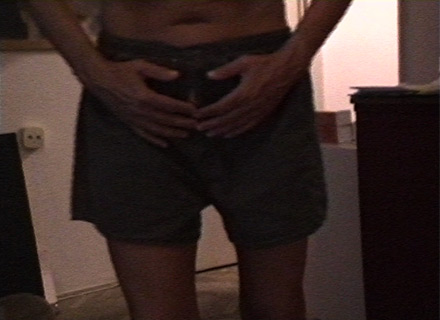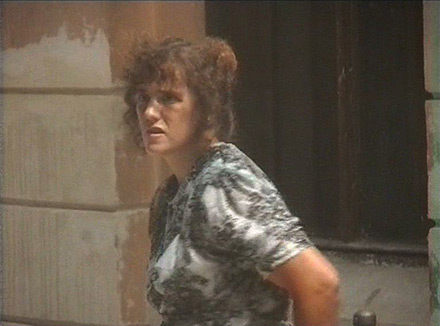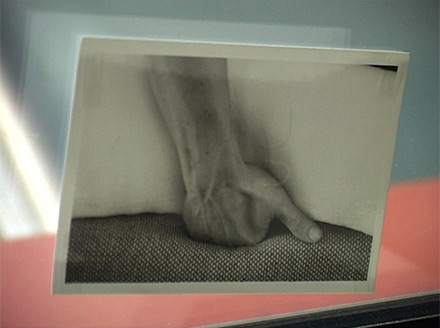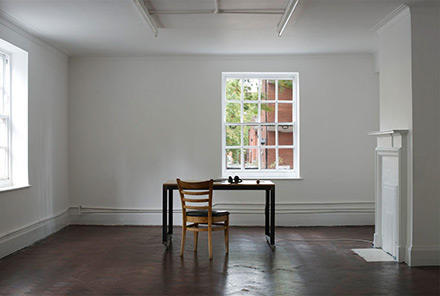Article by Anthony Auerbach commissioned by Futura, Prague, for the catalogue of the exhibition. Published by Futura, Prague, with Czech translation (forthcoming) and by EROS Journal, London (forthcoming).
Daučíková, Daučíkov, A., Anna, aka Anča, A4, artist, author
The subject appears to have been involved in more or less clandestine artistic and homosexual activities, mainly in central and eastern Europe, since the late 1970s. There are indications the subject was trained in applied arts including glass work, as well as fine arts including painting and sculpture, and was at one time a member of the Union of Artists of the USSR. No work of these types, nor any produced during the Soviet period is extant (to our knowledge). Works ascribed to the subject dating from the 1990s onwards exhibit familiarity with surveillance equipment and reporting techniques. The subject is fluent in several languages including Slovak, Czech, Russian and English, and has proven administrative competence by her employment including positions held (among others since the 1990s) of Vice Dean (Academy of Fine Arts and Design, Bratislava), Head of School of New Media and Vice-Rector for Research and International Relations (Academy of Fine Arts, Prague). Documents in our possession (copies) include observations recorded in writing, photographs and moving images. Some of these appear to locate the subject during the 1980s in the Soviet territories of Russia and Ukraine, including the capitals Moscow and Kiev, as well as smaller cities and rural locations. There is no record of employment during the Soviet period.
Additional documents include instruments related to the administration of art such as lists of exhibitions and works, fragmentary biographies, reports and recordings of speaking engagements, commentaries and propaganda material. Additionally, these appear to locate the subject from the 1990s onwards mainly in Bratislava and neighbouring territories including Prague, Vienna and Warsaw as well as at times further afield, for instance, in Berlin, Zürich and London.
Whereas our own informants’ reports may be trusted in so far as they contain direct observations of the subject and were, in some cases, supplemented by photographs, samples of the subject’s handwriting or other evidence, none of the ‘original’ documents mentioned above could be authenticated, independently verified or otherwise corroborated. The information available in them is for the most part insufficient for the identification of other individuals and, where the situations reported are politically, historically and geographically remote, it is unlikely witnesses will be identified or complementary evidence will come to light. Moreover, there are indications the subject may have sought to protect the identities of persons still living and persons unknown or incidental. The naming of persons in the documents may indicate they are now dead. Further interrogation of the subject is therefore recommended.
Although details are scarce, there is nothing to suggest certain isolated facts (for example, the birth year 1950, studies at Academy of Fine Arts, Bratislava in the 1970s) are to be disputed. However, inconsistencies have been observed in secondary documents and in the documents purporting to be art works in which the subject has implicated itself.
Most of the latter may be classified in the following three types.
- Demonstrations about sex recorded indoors
- Opportunistic observations recorded in urban environments
- Verbal accounts of incidents occurring during the Soviet period
Exception A
Some works do not fall wholly into these categories but combine elements of each, for instance: a short video recorded in an urban setting [note 1] claims to be the verbatim re-enactment of an interrogation of the subject that took place as part of the proceedings of a religious divorce. The subject agreed to act as a witness for a woman suing for divorce on the grounds of the man’s inability to satisfy her sexual needs. The video is introduced as follows:
Parish office room; tan unit furniture, a crucifix hanging on the wall; the investigator is a 40-year-old priest, well-trained muscular body; a small, inconspicuous woman sits by a typewriter. They cross themselves, loudly recite a prayer to ‘Our Father’ and begin the investigation.
A split-scene view of a street corner with view to a large church, cars, trams and pedestrians passing by. A person of uncertain gender appears alternately, first on the left, questioning, then, with change of hat, coat and glasses, on the right answering the questions. The person on the right is pressed for details by the priest about a woman’s sexual experience in marriage (to which, apart from the married couple, there was no direct witness). Hadn’t the man’s penis penetrated the woman’s vagina? What was the problem if they had had children? How can a woman know what premature ejaculation is if she hasn’t had sex with other men? How does she know her husband doesn’t satisfy her? Isn’t her wish for sexual fulfilment perverted?
The person acting the roles of both the interrogator and the witness in the case is none other than the author of the video, Anna Daučíková, Anča to her friends.
The video is entitled Portrait of a Woman with Institution – Anča Daučíková with Roman Catholic Church (2011). The author of this (self) portrait steps out of the scene, first to the left, then to the right and makes the viewer wait as she invisibly performs a change of hat, coat and glasses and steps in again on the other side to resume the role of examiner or witness. The title of the piece acknowledges the double and contradictory role of the portrait: at once to mask an individual with a likeness and assimilate it to a genre. The two personae of the piece stand in for the particulars: the familiar Anča and the ancestral church, and render them to the general: woman and institution. The split screen and comically inept disguises stage identity as shuttling appearance. The unity of the individual is either transient — one thing at a time, but altered or exchanged sequentially — or it is split, and so not one at all, but many. The ‘one’ that changes is nowhere to be seen. Daučíková brackets (out) the self.
Type 1
 Fig. 1. We Care About Your Eyes, video, 3 minutes 40 seconds, 2002 (still)
Fig. 1. We Care About Your Eyes, video, 3 minutes 40 seconds, 2002 (still)The subject appears to be working alone. The fly hides no phallus, but instead reveals a mirror (Fig. 1). The mirror reflects the interior and returns the viewer’s gaze. The masturbating hand agitates the scene, bringing it to a climax, anticipated by a ludicrous musical crescendo. This short video is a simulated orgasm, enacted as a lure, as if to attract a look, to capture and observe it. The video is an artificial act, authorised in part by prior video art: the kind of home-made allegory that caused Rosalind Krauss to allege narcissism is ‘video’s real medium’. [note 2] Whereas Narcissus’ is the tale of morbid desire aroused through the medium of reflection, the allure of this piece suggests something different, for self-love without the self is awkward. A title at one time attached to the work hints as much. We Care About Your Eyes (2002) interpellates the viewer with a vague threat redoubled by the confrontation with a cuntish mirror. This mirror aggravates the seductive promise of a requited look and disturbs the comfort of an allegorical fate. This mirror is instead configured as a counter-surveillance device, determined at once to repel and inspect a look.
Two other videos that may be placed in this class exhibit (pseudo) erotic behaviour with optical devices. Queen’s Finger (1997) demonstrates a fingering technique. A lens-like, hollow glass object is grasped firmly in the left hand while penetrated from behind by the thumb of the right hand, teasing and rubbing the interior surface of the glass. The sounds of the skin rubbing the glass are heard, accompanied by the faint whining of the tape transport motor. In Kissing Hour (1997), we see lips pressed against a transparent surface, as if kissing the camera lens, in close-up, for sixty minutes. A third video may be classed with this type in so far as it shares with the others the presentation of handiwork and a certain home-alone quality. The title is Home Exercise (1998). The video stages for the camera an erotic struggle in the form of the work of two gloved hands, the left and right attempting, hand-in-hand, to sew themselves together with needle and thread, until the gloves are off and the needle, alternately caressed by each hand, threatens the skin.
Type 2
 Fig. 2. Ordinary Voyeurism — A Woman, video, 2 minutes 10 seconds, 1995 (still)
Fig. 2. Ordinary Voyeurism — A Woman, video, 2 minutes 10 seconds, 1995 (still)Each video surveys a scene from a fixed viewpoint, observing and, if need be, tracking the target for some minutes:
- A woman waiting (Lviv, Fig. 2)
- A man asleep next to a busy road (Moscow)
- Construction workers at night (Prague)
- Three men on the embankment of a river near a main road (Moscow)
- A woman soliciting money near a cathedral (Vienna)
The five videos of this class enumerated above (dated 1995–2006) were aptly submitted to an archive documenting Video as Urban Condition, a project initiated by the present writer in 2004.
Video, understood as an urban condition, rather than an aspirant genre of art, convinced me that the person with a video camera is a voyeur, and is (or was) so despite the claims made by artists — and, a fortiori, by the manufacturers of mass-market video gadgets and the corporate promoters of user-generated content — that the person with a video camera is an auteur.
My argument, elaborated in the course of the project, was supported by the archive and was perhaps no better exemplified than by Daučíková’s videos, whose manner demonstrates it and whose artistic apparatus, that is, the videos’ titles (little else), re-states it baldly: Ordinary Voyeurism. [note 3]
Nonetheless, from today’s perspective, the argument is delicate and possibly precarious. Video as Urban Condition was launched in 2004 as an archive display and symposium ‘Reflecting on the mutability of video’ [note 4] and lasted roughly until 2008 (when I convened the conference Video needs art history like a TV set needs a plinth [note 5] or 2009 (when I wrote the essay ‘Who is Big Brother? or The Politics of Looking’ [note 6]). During this time, several things happened which drastically altered the terrain on which the study had begun and whose social and subjective implications are yet to be mapped. The technical obsolescence of the project had been anticipated, indeed I had deliberately used just-out-of-date technologies for the archive displays because I wanted the technology to be familiar and banal. The point of the project was to highlight what I called ‘the relations of representation’, rather than advertise the latest ‘forces of production’ (as Marxists would call them). Those relations, to be sure, are mediated by technology, but are determined socially, politically and economically. Thus the project documented a moment in the social history of technology and, arguably, of urban subjectivity, whose passing may be signalled by the technological upheaval that took place in those years.
In the decade of the 2000s, the cathode ray tube, the instrument at the heart of electronic television since its inception in the 1920s, became extinct. [note 7] The tube that had given rise to the box that made video present in three dimensions, which, in turn, had asserted its place in the post-war interior and had supported the sculptural claims of video art, made its final appearance on the street as bulky detritus. YouTube, which quickly came to dominate the distribution of video on the internet, rose from a room-above-a-pizza-shop start-up in 2005 to a 1.6-billion-dollar acquisition by Google the following year. The video sharing service epitomised the social-media bonanza and corporate interest in user-generated content. The iPhone, released in 2007, epitomises the transformation of the telephone into a video (and computing) device. The iPhone was not the first mobile phone to incorporate video recording and distribution capabilities — by 2004 most new phones had cameras in them — nor the first to promote these capabilities in the effort to establish the personal, pocketable device as a site of video consumption. [note 8] In 2005, the already burgeoning video-surveillance infrastructures got an ideological boost following the terrorist bombings in London, when video surveillance recordings had helped, after the fact, to trace the last movements of the suicide attackers. As in the earlier case in England of the abduction murder of two-year-old James Bulger (1993) by two ten-year-old boys, the video recordings were widely publicised. The more sinister the threat, the more comforting the knowledge one is being watched, and the more willing citizens are to identify themselves in public (by various means) and submit to frequent and ubiquitous, if unobtrusive, checks.
As a result of these metamorphoses, the narcissism which was once the preserve of an artistic avant-garde [note 9] became a condition imposed on nearly everyone and, unsurprisingly, was widely embraced. Narcissism became an environmental effect — via the proliferation of closed circuits — and at the same time — via the spread of personal video devices — the medium of self-advertisement, of the authentication of experience and, conversely, of the authentication of the self as the object of the selfie.
In this condition, the subject that had once enjoyed the anonymity afforded by the modern industrial city, that had immersed itself in the crowd and navigated its flow, retreats. The flâneur — sometimes the flâneuse in drag — the covert person, unseen observer, is now at home looking aimlessly out of the window.
Exception B
 Fig. 4. 33 Situations, video installation, 2011–2015 (Vologda, detail)
Fig. 4. 33 Situations, video installation, 2011–2015 (Vologda, detail)The documents constituting Type 3 in our classification (verbal accounts of incidents occurring during the Soviet period, see below) form the pretexts for a series of videos begun in 2011. Each short video explores a different domestic interior in which the view from the window has been partially obscured by placing a copy of a text document on the window pane. Using the same 1990s-vintage video equipment as was used in the works of Type 2 (see above), the voyeuristic gaze, earlier intent on its object, is now adrift in a room. The camera’s searching movement is interrupted by manoeuvres intended to force the viewer of the video to read the text and acknowledge other memorabilia taped to the windows, apparently also related to the subject’s experience in the Soviet Union (Fig. 4). The moving image alights briefly on the face of the room’s inhabitant.
The subject, by force of habit, voyeuristic, holds the fetish — the video camera — and so claims power over what it sees. The interior, the objects placed on the windows, the person who lives there, are all equally, passively enthralled. The situation, produced under an artistic pretext, triangulates the subject with someone from the past and with the other person present in the room, who becomes the object of a fleeting portrait. This portrait, as unsatisfying to the voyeur’s fixed gaze as the languid motion of an auteur movie, appears to bear one of art’s traditional tasks, but one which it has never achieved: the raising of the dead.
Type 3
 Fig. 5. 33 Scenes, audio, 66 minutes, decoy object, 2005–2014 (installation, The Function Room, London)
Fig. 5. 33 Scenes, audio, 66 minutes, decoy object, 2005–2014 (installation, The Function Room, London)The thirty-three short texts published in 2014 [note 10] were written mainly in 2005 and 2006 and consigned to two friends. The Scene Book is a coil-bound A4 pad containing thirty-six tabulated sheets for recording a place, person(s), situation and notes. The situations recorded are located in the Soviet Union, mainly in the 1980s.
The book does not resemble a book. Barely less discreet than its first mode of distribution — which had reached two people — Scene Book rather dissembles a book, transmitting it in disguise. [note 11] The sheets are numbered, and the reports are dated, but the scenes are not arranged chronologically and do not appear to be arranged in a logical or thematic way. They are vivid and consistent only as fragments. The form of each report, if this is what it is, suggests the presence of an eyewitness. However, the notes may also be read as instructions for the enactment or re-enactment of the scene, perhaps for a movie.
The first-person narrator appears only once in the collection (1), not otherwise identified. A woman is identified as participant-observer in several reports and is named variously: ‘Anča, another guest, artist from CSSR ...’ (9), ‘Anna, artist, travelling around ...’ (15), ‘Anča, artist, 29 years old, foreigner, mannish look ...’ (19), ‘Anna Daučíková, Soviet citizen applying for an emigration visa ...’ (22). Additional attributes suggest the same person is the observer in/of several other scenes and establish a biographical arc.
a foreigner from Czechoslovakia (5)
a woman, citizen of Czechoslovakia, 33 years old ... staying in USSR because of a love affair with a Russian woman (2)
female artist, sitting in front of the Commissar (3)
a woman, a foreigner staying permanently in USSR, married to a Soviet citizen. She is lesbian and lives in clandestine relationship with her female lover (25)
a lesbian couple, living under the constant stress of carrying on a surreptitious relationship in a crowded homophobic communal apartment (7)
a woman, artist-glassmaker, 34 years old, former citizen of Czechoslovakia, wearing a blue overall and rubber apron ... a lesbian involved in secret love affairs simultaneously with two straight women (32)
an artist, 35 years old, mannish-looking lesbian, working in her studio (11)
a woman, artist, lesbian, emigrating from the Soviet Union (21)
The book also contains scenes to which Daučíková was not a direct witness but, it seems, would otherwise remain unrecorded. This work may have begun as memory work. Following the deaths of several people of whom Daučíková has conjured glimpses in the scenes, the work comes to an uncertain conclusion as memorial.
The artist is uncertain of her powers. She is trained in the submarine art of navigating Soviet reality, that is, the art of passing: depending on the situation, passing as a woman, as an artist, as a lesbian — if that is how you might be accepted among women, as a wife — if that is how you might be accepted by the state, as a man — if it spared you a kick in the shin, or gained you a secret, dickless satisfaction, as loyal — only as loyal as the situation demands, as true — to your lovers, as indifferent — for to betray your interest would risk exposing you as a stranger, the person who is not who he or she seems. At the time, the stakes were high. You discovered the pleasure in camouflage, because it worked and you remained free, if constrained to cunning. Now you are exiled from the consequences because of emigration to your homeland, because you live, are sober and not silenced.
Anthony Auerbach, London, 2016
![]() back to Anča Daučíková’s artist’s documentation
back to Anča Daučíková’s artist’s documentation
Notes
 Fig. 3. Ordinary Voyeurism — The Passing, video, 3 minutes 20 seconds, 2006 (still)
Fig. 3. Ordinary Voyeurism — The Passing, video, 3 minutes 20 seconds, 2006 (still)- Near the corner of Radlinského and Floriánske námestie, opposite the Church of the Assumption of Virgin Mary, also known as the Blumental, Bratislava. ↩︎
- ‘Video: The Aesthetics of Narcissism’, October, Vol. 1. (Spring, 1976), 57. Krauss claims ‘narcissistic enclosure’ is ‘inherent in the video-medium’ (64). ↩︎
- Alternatively Simply Voyeuristic. The series is not limited to the five examples that have been exhibited.↩︎
- Symposium, 2 July 2004, Austrian Cultural Forum London, with: Juha Huuskonen (Katastro.fi), Manu Luksch (AmbientTV.net), Anna McCarthy (New York University), Paul O’Connor (Undercurrents News Network), Ole Scheeren (Office of Metropolitan Architecture), chaired by Anthony Auerbach. ↩︎
- College Art Association Annual Conference, Dallas, Texas, 23 February 2008. ↩︎
- Published in Dérive Zeitschrift für Stadtforschung, no. 42, January 2011. ↩︎
- Most major manufacturers ceased production during this time, following sharp declines in sales firstly in developed economies. ↩︎
- The first iPhone could not in fact record video. ↩︎
- Bill Viola’s The Passing (1991) is perhaps a good example of such narcissism. The work is a 54-minute compilation of home-videos, created for television, configured in black and white as the interior vision of a man sleeping (the artist himself), enciphering women as the figures of birth (home video of the artist’s wife giving birth to his son) and death (the artist’s mother on her death bed). With bitter irony Daučíková appropriated the title and part of the soundtrack of this work for a short video of a man sleeping on the street with people passing by indifferently in dutiful slow motion. Ordinary Voyeurism — The Passing (2006), Fig. 3. ↩︎
- Anča Daučíková, Scene Book, published by Vargas Organisation, London, 2014. At this time, Daučíková exhibited an audio version 33 Scenes (The Function Room, London, 2014, Fig. 5). ↩︎
- Only 100 copies of Scene Book were printed. The audio version had an audience of one — at a time. ↩︎